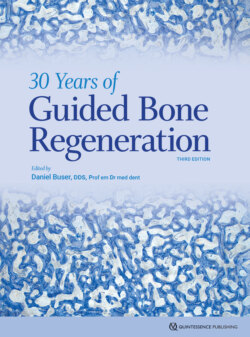Читать книгу 30 Years of Guided Bone Regeneration - Daniel Buser - Страница 8
На сайте Литреса книга снята с продажи.
ОглавлениеPreface
The utilization of barrier membranes for the regeneration of bone defects has significantly changed implant dentistry in the past 30 years and clearly expanded the utilization of dental implants in patients. This principle is called guided bone regeneration (GBR or GBR technique), and was first described in 1959 by Hurley and colleagues for the treatment of experimental spinal fusion. In the 1960s, the research teams of Bassett and Boyne tested Millipore filters for the healing of cortical defects in long bones and osseous facial reconstruction, respectively. The authors utilized these filters to establish a suitable environment for osteogenesis by excluding fibrous connective tissue cells from bone defects. However, these studies did not lead to a clinical application of barrier membranes in patients at that time.
The clinical potential of barrier membranes was picked up in the early 1980s in the field of periodontology by the research team of Nyman and Karring, who systematically examined barrier membranes for periodontal regeneration. A few years later, barrier membranes were also tested for the regeneration of bone defects in experimental studies. The first three studies were done in Gothenburg by Dahlin and Nyman. Based on promising results in these studies, clinical testing of barrier membranes began in implant patients in the late 1980s. After 5 years of intensive experimental and clinical work, the first edition of the textbook Guided Bone Regeneration in Implant Dentistry was published in 1994, and it received a high interest by readers in the field of implant dentistry. In 2009, the second edition of the GBR book was published with an update of the scientific knowledge and the surgical techniques being utilized after 20 years of a wide clinical application of GBR.
In the past 12 years, the scientific knowledge and the clinical experience have evolved further. During these years, many fine-tuning efforts have been made for the various surgical techniques to improve the regenerative outcomes, or to reduce the surgical invasiveness for patients. Therefore, it was time to make a new effort to once again analyze the scientific basis of the GBR technique and its clinical applications. The result is in your hands, the third edition of the GBR book, called 30 Years of Guided Bone Regeneration in Implant Dentistry. This book is again written for the surgical clinician with an interest and experience in implant dentistry.
As an introduction to the topic of the book, chapter 1 discusses the development and fine-tuning phase of the GBR technique over the past 30 years. Chapter 2 covers the biologic basis of bone regeneration and presents a scientific update on bone formation and bone remodeling. The excellent histology utilizing nondecalcified sections is based on more than 30 years of experimental research, and it presents the details of bone regeneration in general and the details of bone formation in membrane-protected defects with bone grafts or bone substitutes in particular. Chapter 3 is completely new and describes the molecular and cellular characteristics of autogenous bone chips, and how they release various growth factors when put in a mixture of blood and physiologic and sterile saline. Chapter 4 is also completely new and describes the hard and soft tissue alterations following tooth extraction. Clinicians need to understand these biologic mechanisms for proper selection of the most suitable treatment option in postextraction implant placement. Chapter 5 is also new and systematically describes the surgical and anatomical factors influencing the regenerative outcome of GBR procedures, including the interesting classifications of defect morphology.
In the clinical section of the book, chapters 6 to 14, clinical procedures associated with different indications of the GBR technique are presented in detail. Each chapter deals with specific indications and describes the criteria for patient selection, the step-by-step surgical procedure, and aspects of postoperative treatment. Emphasis is given to incision technique and flap design; the selection, handling, and placement of barrier membranes; the combination of membranes with autogenous bone grafts and low-substitution bone fillers; and aspects of wound closure. These chapters of the book reflect the immense progress and excellent documentation of GBR in the past 10 to 15 years, and its outstanding importance in daily practice of implant therapy.
Acknowledgments
As editor, I cordially thank all authors and coauthors for their great effort and time to realize this textbook. It has been very intensive work during a pandemic crisis, but a satisfying experience to collaborate with colleagues of such international reputation and high quality. Some of them are long-term personal friends, which makes the pleasure even greater. I also want to share that all authors, including myself, agreed to have the authors’ royalties entirely paid into the Buser Implant Foundation, a foundation established in August 2019 right after my retirement as Professor and Chairman at the Department of Oral Surgery and Stomatology, University of Bern, after 20 years of service. The foundation’s objectives are the promotion of education and research in the field of implant dentistry by providing personal stipends and junior investigator grants to young colleagues of our profession. The first Buser Foundation Scholarship in Implant Dentistry has been awarded in spring 2021.
I also thank Bernadette Rawyler, who created all the beautiful digital artwork in my chapters. These illustrations have made it much easier to communicate the correct messages and necessary information from the authors to the reader.
Last but not least, I also cordially thank Bryn Grisham and Marieke Zaffron of Quintessence Publishing for their excellent collaboration to realize this book. The quality work and the quality printing of Quintessence was again superb and is highly appreciated. It reflects almost 30 years of close collaboration with Quintessence Publishing, both in Berlin and in Chicago. I thank Horst Wolfgang Haase, Christian W. Haase, as well as Alexander Ammann for this excellent collaboration over so many years, which was based on trust, respect, and friendship.
